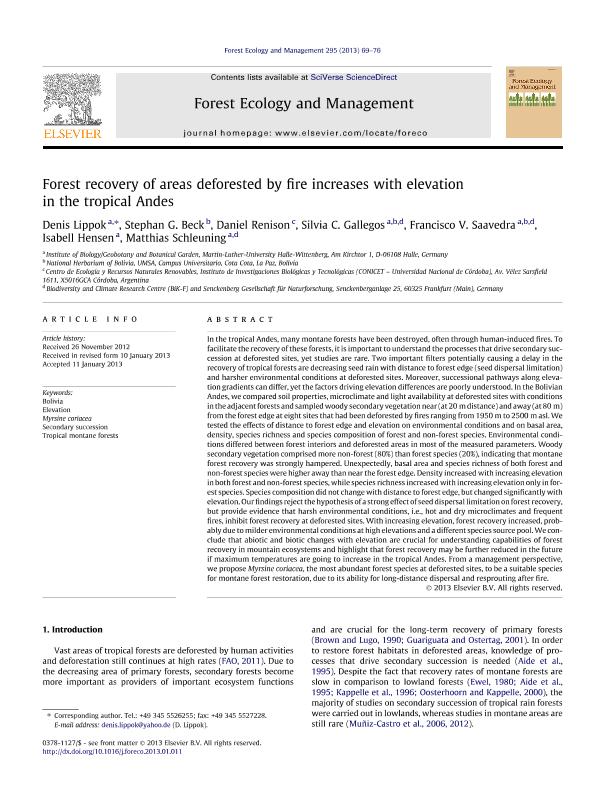Artículo
Forest recovery of areas deforested by fire increases with elevation in the tropical Andes
Lippok, Denis; Beck, Stephan G.; Renison, Daniel ; Gallegos, Silvia C.; Saavedra, Francisco V.; Hensen, Isabell; Schleuning, Matthias
; Gallegos, Silvia C.; Saavedra, Francisco V.; Hensen, Isabell; Schleuning, Matthias
 ; Gallegos, Silvia C.; Saavedra, Francisco V.; Hensen, Isabell; Schleuning, Matthias
; Gallegos, Silvia C.; Saavedra, Francisco V.; Hensen, Isabell; Schleuning, Matthias
Fecha de publicación:
02/2013
Editorial:
Elsevier Science
Revista:
Forest Ecology and Management
ISSN:
0378-1127
Idioma:
Inglés
Tipo de recurso:
Artículo publicado
Clasificación temática:
Resumen
In the tropical Andes, many montane forests have been destroyed, often through human-induced fires. To facilitate the recovery of these forests, it is important to understand the processes that drive secondary succession at deforested sites, yet studies are rare. Two important filters potentially causing a delay in the recovery of tropical forests are decreasing seed rain with distance to forest edge (seed dispersal limitation) and harsher environmental conditions at deforested sites. Moreover, successional pathways along elevation gradients can differ, yet the factors driving elevation differences are poorly understood. In the Bolivian Andes, we compared soil properties, microclimate and light availability at deforested sites with conditions in the adjacent forests and sampled woody secondary vegetation near (at 20 m distance) and away (at 80 m) from the forest edge at eight sites that had been deforested by fires ranging from 1950 m to 2500 m asl. We tested the effects of distance to forest edge and elevation on environmental conditions and on basal area, density, species richness and species composition of forest and non-forest species. Environmental conditions differed between forest interiors and deforested areas in most of the measured parameters. Woody secondary vegetation comprised more non-forest (80%) than forest species (20%), indicating that montane forest recovery was strongly hampered. Unexpectedly, basal area and species richness of both forest and non-forest species were higher away than near the forest edge. Density increased with increasing elevation in both forest and non-forest species, while species richness increased with increasing elevation only in forest species. Species composition did not change with distance to forest edge, but changed significantly with elevation. Our findings reject the hypothesis of a strong effect of seed dispersal limitation on forest recovery, but provide evidence that harsh environmental conditions, i.e., hot and dry microclimates and frequent fires, inhibit forest recovery at deforested sites. With increasing elevation, forest recovery increased, probably due to milder environmental conditions at high elevations and a different species source pool. We conclude that abiotic and biotic changes with elevation are crucial for understanding capabilities of forest recovery in mountain ecosystems and highlight that forest recovery may be further reduced in the future if maximum temperatures are going to increase in the tropical Andes. From a management perspective, we propose Myrsine coriacea, the most abundant forest species at deforested sites, to be a suitable species for montane forest restoration, due to its ability for long-distance dispersal and resprouting after fire.
Palabras clave:
Andes
,
Elevation
,
Environmental Conditions
,
Secondary Succession
Archivos asociados
Licencia
Identificadores
Colecciones
Articulos(IIBYT)
Articulos de INSTITUTO DE INVESTIGACIONES BIOLOGICAS Y TECNOLOGICAS
Articulos de INSTITUTO DE INVESTIGACIONES BIOLOGICAS Y TECNOLOGICAS
Citación
Lippok, Denis; Beck, Stephan G.; Renison, Daniel; Gallegos, Silvia C.; Saavedra, Francisco V.; et al.; Forest recovery of areas deforested by fire increases with elevation in the tropical Andes; Elsevier Science; Forest Ecology and Management; 295; 2-2013; 69-76
Compartir
Altmétricas



